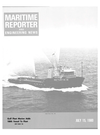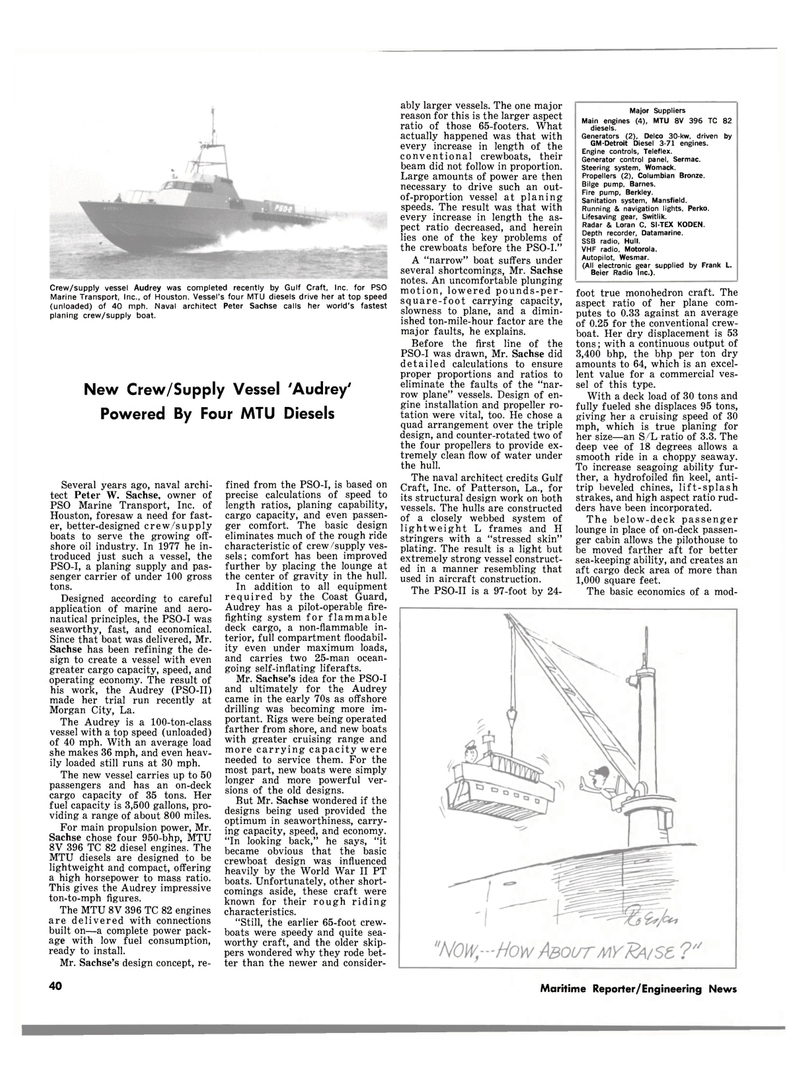
Page 40: of Maritime Reporter Magazine (July 15, 1980)
Read this page in Pdf, Flash or Html5 edition of July 15, 1980 Maritime Reporter Magazine
Crew/supply vessel Audrey was completed recently by Gulf Craft, Inc. for PSO
Marine Transport, Inc., of Houston. Vessel's four MTU diesels drive her at top speed (unloaded) of 40 mph. Naval architect Peter Sachse calls her world's fastest planing crew/supply boat.
New Crew/Supply Vessel 'Audrey'
Powered By Four MTU Diesels
Several years ago, naval archi- tect Peter W. Sachse, owner of
PSO Marine Transport, Inc. of
Houston, foresaw a need for fast- er, better-designed crew/supply boats to serve the growing off- shore oil industry. In 1977 he in- troduced just such a vessel, the
PSO-I, a planing supply and pas- senger carrier of under 100 gross tons.
Designed according to careful application of marine and aero- nautical principles, the PSO-I was seaworthy, fast, and economical.
Since that boat was delivered, Mr.
Sachse has been refining the de- sign to create a vessel with even greater cargo capacity, speed, and operating economy. The result of his work, the Audrey (PSO-II) made her trial run recently at
Morgan City, La.
The Audrey is a 100-ton-class vessel with a top speed (unloaded) of 40 mph. With an average load she makes 36 mph, and even heav- ily loaded still runs at 30 mph.
The new vessel carries up to 50 passengers and has an on-deck cargo capacity of 35 tons. Her fuel capacity is 3,500 gallons, pro- viding a range of about 800 miles.
For main propulsion power, Mr.
Sachse chose four 950-bhp, MTU 8V 396 TC 82 diesel engines. The
MTU diesels are designed to be lightweight and compact, offering a high horsepower to mass ratio.
This gives the Audrey impressive ton-to-mph figures.
The MTU 8V 396 TC 82 engines are delivered with connections built on—a complete power pack- age with low fuel consumption, ready to install.
Mr. Sachse's design concept, re- fined from the PSO-I, is based on precise calculations of speed to length ratios, planing capability, cargo capacity, and even passen- ger comfort. The basic design eliminates much of the rough ride characteristic of crew/supply ves- sels ; comfort has been improved further by placing the lounge at the center of gravity in the hull.
In addition to all equipment required by the Coast Guard,
Audrey has a pilot-operable fire- fighting system for flammable deck cargo, a non-flammable in- terior, full compartment floodabil- ity even under maximum loads, and carries two 25-man ocean- going self-inflating liferafts.
Mr. Sachse's idea for the PSO-I and ultimately for the Audrey came in the early 70s as offshore drilling was becoming more im- portant. Rigs were being operated farther from shore, and new boats with greater cruising range and more carrying capacity were needed to service them. For the most part, new boats were simply longer and more powerful ver- sions of the old designs.
But Mr. Sachse wondered if the designs being used provided the optimum in seaworthiness, carry- ing capacity, speed, and economy. "In looking back," he says, "it became obvious that the basic crewboat design was influenced heavily by the World War II PT boats. Unfortunately, other short- comings aside, these craft were known for their rough riding characteristics. "Still, the earlier 65-foot crew- boats were speedy and quite sea- worthy craft, and the older skip- pers wondered why they rode bet- ter than the newer and consider- ably larger vessels. The one major reason for this is the larger aspect ratio of those 65-footers. What actually happened was that with every increase in length of the conventional crewboats, their beam did not follow in proportion.
Large amounts of power are then necessary to drive such an out- of-proportion vessel at planing speeds. The result was that with every increase in length the as- pect ratio decreased, and herein lies one of the key problems of the crewboats before the PSO-I."
A "narrow" boat suffers under several shortcomings, Mr. Sachse notes. An uncomfortable plunging motion, lowered pounds-per- square-foot carrying capacity, slowness to plane, and a dimin- ished ton-mile-hour factor are the major faults, he explains.
Before the first line of the
PSO-I was drawn, Mr. Sachse did detailed calculations to ensure proper proportions and ratios to eliminate the faults of the "nar- row plane" vessels. Design of en- gine installation and propeller ro- tation were vital, too. He chose a quad arrangement over the triple design, and counter-rotated two of the four propellers to provide ex- tremely clean flow of water under the hull.
The naval architect credits Gulf
Craft, Inc. of Patterson, La., for its structural design work on both vessels. The hulls are constructed of a closely webbed system of lightweight L frames and H stringers with a "stressed skin" plating. The result is a light but extremely strong vessel construct- ed in a manner resembling that used in aircraft construction.
The PSO-II is a 97-foot by 24-
Major Suppliers
Main engines (4), MTU 8V 396 TC 82 diesels.
Generators (2), Delco 30-kw, driven by
GM-Detroit Diesel 3-71 engines.
Engine controls, Teleflex.
Generator control panel, Sermac.
Steering system, Womack.
Propellers (2), Columbian Bronze.
Bilge pump, Barnes.
Fire pump, Berkley.
Sanitation system, Mansfield.
Running & navigation lights, Perko.
Lifesaving gear, Switlik.
Radar & Loran C, SI-TEX KODEN.
Depth recorder, Datamarine.
SSB radio, Hull.
VHF radio, Motorola.
Autopilot, Wesmar. (All electronic gear supplied by Frank L.
Beier Radio Inc.). foot true monohedron craft. The aspect ratio of her plane com- putes to 0.33 against an average of 0.25 for the conventional crew- boat. Her dry displacement is 53 tons; with a continuous output of 3,400 bhp, the bhp per ton dry amounts to 64, which is an excel- lent value for a commercial ves- sel of this type.
With a deck load of 30 tons and fully fueled she displaces 95 tons, giving her a cruising speed of 30 mph, which is true planing for her size—an S/L ratio of 3.3. The deep vee of 18 degrees allows a smooth ride in a choppy seaway.
To increase seagoing ability fur- ther, a hydrofoiled fin keel, anti- trip beveled chines, lift-splash strakes, and high aspect ratio rud- ders have been incorporated.
The below-deck passenger lounge in place of on-deck passen- ger cabin allows the pilothouse to be moved farther aft for better sea-keeping ability, and creates an aft cargo deck area of more than 1,000 square feet.
The basic economics of a mod- 40 ZIDELL Maritime Reporter/Engineering News

 39
39

 41
41
